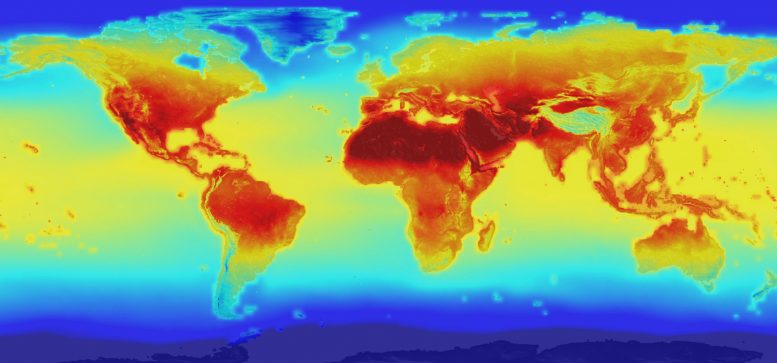
NASA introduced a climate action plan to mitigate mission impacts from climate change, enhance facility resilience, and provide unique climate observations, analysis, and modeling through scientific research.
NASA released a climate action plan on October 7, 2021, aimed at averting mission impacts due to climate change, ensuring the resiliency of facilities and assets, and providing the nation and world unique climate observations, analysis, and modeling through scientific research.
The plan is part of President Biden’s whole-of-government approach to confronting the climate crisis. Federal agencies face rising maintenance and repair costs due to more frequent and extreme weather events, health and safety challenges to employees for work outside, and potential issues with program effectiveness. To address these and other challenges, President Biden prioritized federal agency climate adaptation and resilience planning. Through this approach, NASA and 22 other large agencies developed climate action plans, to address their most significant climate risks and vulnerabilities.
“NASA has unique assets it must protect – scientific equipment and capabilities that allow us to understand this climate crisis on Earth as well as explore the universe,” said NASA Administrator Bill Nelson. “Thankfully, we have the ingenuity and engineering capability to ensure our agency’s resources remain resilient from this growing threat. NASA is committed to safeguarding our mission in the decades to come, and through the data we provide to the world, we’ll help other agencies make sure they can do the same.”

NASA is one of a few federal agencies that conducts climate research and provides data critical for governments, private companies, and others across the globe. Thanks to decades of commitment to supporting scientists and deploying technology, NASA’s climate-related research encompasses solar activity, sea level rise, ocean and atmospheric temperatures, ozone layer conditions, air pollution, greenhouse gas levels, and changes in sea ice and land ice.
But even as NASA conducts this research, its facilities, vehicles, equipment, and infrastructure face threats related to climate change. Approximately two-thirds of agency assets when measured by replacement value are located within 16 feet of mean sea level along America’s coasts. Some of these assets are located in areas already experiencing high water levels and other impacts from sea level rise. Temperature, precipitation, and extreme weather events are expected to affect others.
Agencies submitted their plans for review by the National Climate Task Force, White House Council on Environmental Quality’s Federal Chief Sustainability Officer, and the Office of Management and Budget (OMB) in response to President Biden’s Executive Order on Tackling the Climate Crisis at Home and Abroad. Using their plans, agencies will embed adaptation and resilience planning and implementation throughout their operations and programs and will continually update their adaptation plans.
The plans also address the need to leverage procurement in ways that drive innovation and increase resilience against supply chain disruptions, in line with the President’s commitment to implementing his Justice40 Initiative. In addition to these plans, President Biden’s Build Back Better Agenda and the Bipartisan Infrastructure Deal include bold, historic, and transformational investments to strengthen our nation’s resilience to climate change and extreme weather events, including upgrading power infrastructure, rebuilding America’s roads and bridges, and more.
To ensure accountability, NASA’s plan identifies officials and areas of the agency responsible for addressing its priorities and areas of focus. Strategic priorities in NASA’s plan include:
- Ensuring access to space. NASA will identify climate change-related vulnerabilities that threaten access to space, perform risk assessments, and develop risk reduction strategies to enable prioritizing adaptations.
- Integrating climate adaptation into NASA’s master plans. The agency will work to better integrate climate risk analysis and adaptation strategies into facility and infrastructure project prioritization processes.
- Integrating climate change into risk analysis and resilience planning. The agency will integrate the results of resilience planning into the master plans for its centers, and into operations and maintenance processes.
- Updating climate modeling to better understand threats and vulnerabilities. NASA will develop next generation climate models, generate improved data on Earth’s water and energy cycle, and create a connection between NASA climate science data and the agency’s Geographic Information Systems. These actions will assist other agencies and help NASA improve its risk planning.
- Advancing aeronautics research to reduce contributors to climate change. NASA will collaborate with partners to develop and implement aviation solutions that enable climate adaptation, while supporting the aviation community’s goal to aggressively reduce emissions of carbon dioxide.
The White House Council on Environmental Quality (CEQ) and Office of Management and Budget seek public input on the plans released by NASA and other agencies. Members of the public may submit comments until November 6, 2021 via the docket (Docket ID: CEQ–2021–0003) at:
CEQ also will hold a virtual convening this fall with national organizations that have expertise in climate adaptation and resilience or have expressed interest in the agency plans.
The Agencies releasing a Climate Action Plan are:
- Department of Agriculture
- Department of Commerce
- Department of Defense
- Department of Education
- Department of Energy
- Department of Health and Human Services
- Department of Homeland Security
- Department of Housing and Urban Development
- Department of the Interior
- Department of Justice
- Department of Labor
- Department of State
- Department of the Treasury
- Department of Transportation
- Department of Veterans Affairs
- Development Finance Corporation
- Environmental Protection Agency
- General Services Administration
- NASA
- Office of Personal Management
- Smithsonian Institution
- U.S. Agency for International Development
- U.S. Army Corps of Engineers
All plans are available at:









Be the first to comment on "NASA Releases Climate Action Plan"